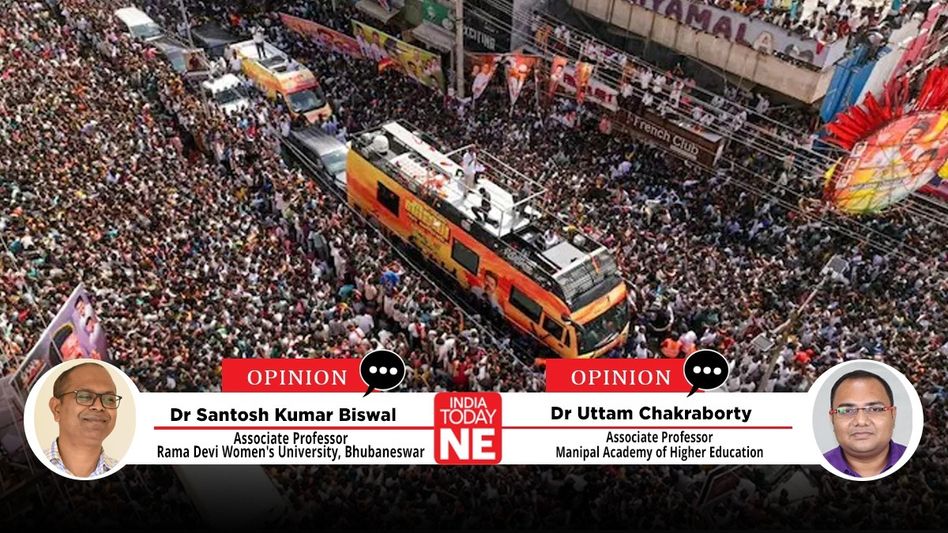Stampede, Deliberative Democracy and Public Sphere
In the chaos of yet another stampede, the vulnerable are drawn in by promises and gifts only to be abandoned by a system that values spectacle over safety, leaving lives expendable and voices unheard. Democracy falters when inclusion is ignored.

Again, one more stampede. Forty-one people paid with their lives. Again, the public sphere collapsed under its own inequalities, exclusions and neglect. There was a breakdown of communication channels, or exclusion was built into the communicative design. The voice of the poor is silenced again.
At this juncture, Jürgen Habermas’ ideas of the public sphere - a space where citizens come together, deliberate rationally, and shape their democratic lives- deserve to be deliberated. Habermas argues that real democracy must have inclusion, discussion, and equality of participation. Stampedes caused because of political rallies in India show the contrary and remain a spectacle instead of safety, populism instead of deliberation, and exclusion instead of inclusion. The poor are physically present in rallies or welfare events, but they are denied agency, dignity and voice.
The stampede in the district of Karur, Tamil Nadu, during a free distribution event linked to Tamilaga Vettri Kazhagam (TVK) president and actor-turned-politician Joseph Vijay Chandrasekhar, tragically claimed the lives of poor women, the most vulnerable subaltern in India’s public sphere. This was not the only stampede, rather a trail of such unfortunate events, which claimed over 80 people in various forms this year itself. They were rendered as a mere part of the crowd. Their lives were only of value for political mobilisation or media spectacle. The deaths at Karur, like those at railway stations or festival grounds, demonstrate how little protection or respect they afford.
The political event mercilessly drew the crowds, and safety was grossly neglected, which eventually reduced the citizens to expendable bodies. The news media reported merely the numbers, as usual, as part of the media agenda to spur the circulation, viewership, and digital traffic. However, in the lens of Habermas' subalterns’, voices and experiences remain unheard, unprotected and undervalued in dominant public discourse.
A vibrant democracy requires valuing the safety and dignity of citizens, especially the most vulnerable. Until political spectacle is paired with accountability, infrastructure and planning, events designed to display generosity will continue to repeat fatal risks. Such incidents can be attributed to the vacuum in politics. Political responsiveness has generally been reduced to the activity of cheering our leaders. Suffice to say, it is not able to negotiate for the terms of policies, institutional accountability, or social rights. Again, Mahatma Gandhi’s Swaraj on community agency and Hannah Arendt’s dialogue and plurality are grossly missing in the narratives of contemporary politics. This calls for an inclusive public sphere.
These days, subalterns are not restricted to the castes, tribes, disabled, women or children alone. The new additions could be the gig and platform workers who lack job security, social protection, and labour rights, even though they participate in the urban economy. Similarly, the informal sector and migrant workers are often excluded from welfare programs. These newly added groups are pushing the think-tanks to revisit Habermas’s ideation of the public sphere. He emphasises inclusiveness through rational debates where citizens influence political life. In the contemporary Indian context, Hebermas’ framework of subalternity is not only about caste or rural status, rather extends to anyone economically or socially marginalised, covering the workers in the informal economy, gig platforms, and precarious labour markets.
As seen in the stampedes during the RCB’s victory festivities and at New Delhi Railway Station, the death toll in Tamil Nadu has again highlighted the risks associated with poorly managed public gatherings. Most of the victims were women and poor individuals, who were drawn in by the offer of gifts at a political distribution event. When the media highlights the extent of rallies and such distribution events, the physical and human capacities of the people are barely prioritised.
With no surprise, political stampedes manifest a negotiation within the space of the public sphere. Ideally, rallies and meetings are sites of collective expression where citizens need to be deliberative and democratic. However, the reality is quite the opposite. The stampede has merely been reduced to a metaphor for how the marginalised enter normal life without the proper information, control, and care.
The Tamil Nadu stampede reminds us that populist appeal should never come at the cost of human life. The agency of the marginalised is in decline due to systemic marginalisation, elite-driven governance, and digital divides. Their voices are often co-opted or silenced, reducing participation in decision-making and weakening grassroots mobilisation in democratic and authoritarian contexts.
Precisely, you may recall Antonio Gramsci’s cultural hegemony, Gayatri Spivak’s ‘Can the Subaltern Speak?’, Hannah Arendt’s necessity of public spaces or Michel Foucault’s notion of power or knowledge. All of these philosophers highlight the dominant discourse and institutions which further define legitimacy and silence subaltern narratives. Moreover, Max Weber is startled by citing the emergence of popular leaders across the globe who oppose broad-based democratic participation, curtailing the collective decision-making process.
As always, the corporate media house plays a curious role. The stampedes or incidents dominate the news headlines in the days after. Again, this is the apathy of the dominant media discourse on such a serious matter. In most cases, the media does not thoroughly follow up on the story days later. No wonder, out of sight is out of mind!
Copyright©2025 Living Media India Limited. For reprint rights: Syndications Today









